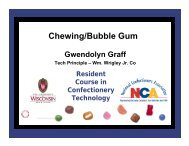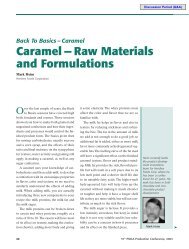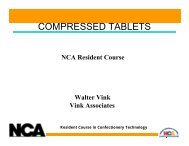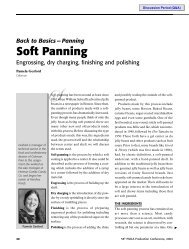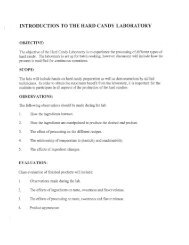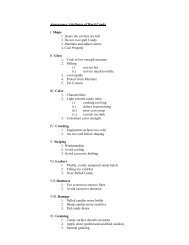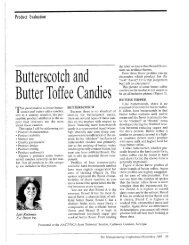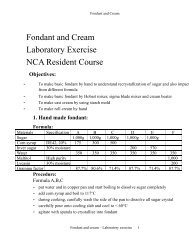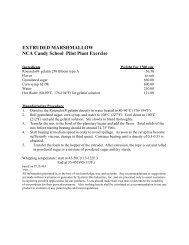2001 Grained and Ungrained Confections - staging.files.cms.plus.com
2001 Grained and Ungrained Confections - staging.files.cms.plus.com
2001 Grained and Ungrained Confections - staging.files.cms.plus.com
You also want an ePaper? Increase the reach of your titles
YUMPU automatically turns print PDFs into web optimized ePapers that Google loves.
Concentration<br />
The concentration of each of the ingredients<br />
in the syrup <strong>and</strong> its solubility in water<br />
at room temperature must be known. If<br />
any of them are more concentrated than<br />
their solubility, they potentially can crystallize<br />
to precipitate the excess, leaving the<br />
syrup saturated with the ingredient.<br />
Although the ingredient potentially can<br />
crystallize, it may not if its molecules cannot<br />
<strong>com</strong>e together to form crystals because,<br />
for instance, a gelling agent prevents them<br />
from moving, or some of the other factors<br />
listed below are having a similar effect.<br />
The situation is <strong>com</strong>plicated by the interactions<br />
between all of the ingredients, all<br />
<strong>com</strong>peting for the water in the syrup.Thus<br />
it is their mixed solubility which is important<br />
to know in evaluating their ability to<br />
crystallize.<br />
For most of the grained confections we<br />
will discuss, sugar is the ingredient which<br />
crystallizes from the syrup binding the confection<br />
together, leaving up to 68 percent<br />
sugar, at room temperature, still in solution<br />
to help stabilize the product.<br />
Viscosity of the Syrup<br />
Gelling agents effectively immobilize the<br />
sugar molecules in jellies <strong>and</strong> prevent sugar<br />
crystallization from taking place.Other ingredients,<br />
particularly the long chain dextrins<br />
in corn syrup, increase the viscosity of a<br />
syrup. The higher their concentration the<br />
more viscous the syrup be<strong>com</strong>es <strong>and</strong> the<br />
more difficult for crystallization to take place.<br />
The extreme effect of viscosity is shown<br />
in hard c<strong>and</strong>y where the moisture content<br />
is so low (2–3%) that the sugar in the<br />
recipe should crystallize, but the viscosity of<br />
the sugar glass is so high that it cannot.<br />
However, when st<strong>and</strong>ard hard c<strong>and</strong>y is<br />
left unwrapped, it picks up moisture from<br />
the atmosphere. The syrup formed on the<br />
surface is lower in viscosity <strong>and</strong> sugar crys-<br />
<strong>Grained</strong> <strong>and</strong> <strong>Ungrained</strong> <strong>Confections</strong><br />
tals can form to give a grained skin on the<br />
product. If the dextrin content of the recipe<br />
is high enough by using, for instance, a<br />
recipe with 50 percent low 36 de corn<br />
syrup in it, surface graining may not take<br />
place but the surface gets sticky.<br />
Viscosity is also affected by temperature.<br />
It increases as the temperature is lowered.<br />
If products are stored in cold rooms or in<br />
freezers, crystallization can be inhibited<br />
even though the solubility of sugar is<br />
reduced as the temperature is lowered. It is<br />
like gold fish in a fish bowl.When the water<br />
is at room temperature, the fish can swim<br />
around happily <strong>and</strong> collect together, but<br />
when the bowl is put in a freezer, the fish<br />
are locked in ice <strong>and</strong> cannot move. If we<br />
think of the sugar molecules in a syrup as<br />
the fish, you can visualize the effect of temperature<br />
on crystallization.<br />
Seeding of the Syrup<br />
Crystallization is made easier when the<br />
sugar molecules are given a pattern to follow<br />
in forming crystals. If sugar crystals are<br />
mixed into the syrup, crystallization is initiated.The<br />
more that are added, the greater<br />
the chance of graining taking place. This is<br />
similar to seeding chocolate by tempering<br />
to provide a pattern for cocoa butter to crystallize.<br />
Seeding with fine sugar crystals, in<br />
the form of fondant, is an important part of<br />
grained-confections technology.<br />
Mixing<br />
Crystallization of a syrup is helped considerably<br />
by agitation or mixing it to assist<br />
the sugar molecules to <strong>com</strong>e together to<br />
form crystals. Generally the more vigorous<br />
the mixing, the faster the syrup will grain<br />
<strong>and</strong> the smaller the sugar crystals which<br />
form. Slow crystallization generally produces<br />
large crystals.<br />
Cooling <strong>and</strong> Temperature<br />
When sugar crystallizes from a syrup it ➤<br />
It is not possible<br />
to produce a shelfstable<br />
syrup-based<br />
confection from<br />
sugar alone.<br />
55 th PMCA Production Conference, <strong>2001</strong> 45



